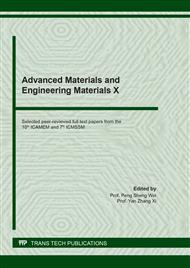[1]
M. Barczewski and O. Mysiukiewicz, Rheological and processing properties of poly(lactic acid) composites filled with ground chestnut shell,, Polym., vol. 42, no. 2, p.267–274, (2018).
DOI: 10.7317/pk.2018.42.2.267
Google Scholar
[2]
X. Huang and A. Netravali, Biodegradable green composites made using bamboo micro/nano-fibrils and chemically modified soy protein resin,, Compos. Sci. Technol., vol. 69, no. 7–8, p.1009–1015, (2009).
DOI: 10.1016/j.compscitech.2009.01.014
Google Scholar
[3]
M. Murariu and P. Dubois, PLA composites: From production to properties,, Adv. Drug Deliv. Rev., vol. 107, p.17–46, (2016).
DOI: 10.1016/j.addr.2016.04.003
Google Scholar
[4]
M. A. Elsawy, K. H. Kim, J. W. Park, and A. Deep, Hydrolytic degradation of polylactic acid (PLA) and its composites,, Renew. Sustain. Energy Rev., vol. 79, no. May, p.1346–1352, (2017).
DOI: 10.1016/j.rser.2017.05.143
Google Scholar
[5]
S. Sousa, A. Costa, A. Silva, and R. Simões, Poly(lactic acid)/Cellulose films produced from composite spheres prepared by emulsion-solvent evaporation method,, Polymers (Basel)., vol. 11, no. 1, p.1–19, (2019).
DOI: 10.3390/polym11010066
Google Scholar
[6]
M. R. Mohammed and A. N. Hadi, Effect of Egg Shells Powder on Some Mechanical and Physical Properties of Natural Rubber ( Nr ),, Iraqi J. Mech. Mater. Eng., vol. 12, no. 3, p.446–458, (2012).
Google Scholar
[7]
L. Běhálek, M. Maršálková, P. Lenfeld, J. Habr, J. Bobek, and M. Seidl, Study of crystallization of polylactic acid composites and nanocomposites with natural fibres by DSC method,, NANOCON 2013 - Conf. Proceedings, 5th Int. Conf., p.746–751, (2013).
Google Scholar
[8]
A. Wiriya-amornchai and P. Nu-yang, Effect of Soybean Oil in Eggshell Powder Filled Polylactic Acid Composites on its Mechanical , Thermal and Rheological Properties,, vol. 990, p.204–208, (2020).
DOI: 10.4028/www.scientific.net/msf.990.204
Google Scholar
[9]
H. S. Kim and H. J. Kim, Miscibility and performance evaluation of natural-flour-filled PP/PBS and PP/PLA bio-composites,, Fibers Polym., vol. 14, no. 5, p.793–803, (2013).
DOI: 10.1007/s12221-013-0793-0
Google Scholar
[10]
N. Hongsriphan, P. Dangmanee, M. Mankrut, and W. Jantaraka, Mechanical and thermal properties of eucalyptus fiber composites from blend between biodegradable poly(butylene succinate) and recycled PET,, J. Met. Mater. Miner., vol. 27, no. 1, p.13–23, (2017).
Google Scholar
[11]
S. H. Jasim, W. Alhassan, and Z. T. Almalki, Egg Shell powder reinforced Polypropylene (PP) composite: Effect of mechanical and heat capacity,, Al-Qadisiyah J. Pure Sci., vol. 25, no. 3, p.16–27, (2020).
DOI: 10.29350/qjps.2020.25.3.1109
Google Scholar
[12]
J. Z. Xu, Z. J. Zhang, H. Xu, J. Bin Chen, R. Ran, and Z. M. Li, Highly Enhanced Crystallization Kinetics of Poly(l -lactic acid) by Poly(ethylene glycol) Grafted Graphene Oxide Simultaneously as Heterogeneous Nucleation Agent and Chain Mobility Promoter,, Macromolecules, vol. 48, no. 14, p.4891–4900, (2015).
DOI: 10.1021/acs.macromol.5b00462
Google Scholar
[13]
R. Homklin and N. Hongsriphan, Mechanical and thermal properties of PLA/PBS cocontinuous blends adding nucleating agent,, Energy Procedia, vol. 34, p.871–879, (2013).
DOI: 10.1016/j.egypro.2013.06.824
Google Scholar
[14]
J. Zhang, D. X. Yan, J. Z. Xu, H. D. Huang, J. Lei, and Z. M. Li, Highly crystallized poly (lactic acid) under high pressure,, AIP Adv., vol. 2, no. 4, (2012).
DOI: 10.1063/1.4769351
Google Scholar
[15]
R. N. Farahana, A. G. Supri, and P. L. Teh, Effect of Benzyl Urea on Properties of Recycled High Density Polyethylene/Ethylene Vinyl Acetate/Egg Shell Powder Composites,, Appl. Mech. Mater., vol. 695, no. 1, p.40–43, (2014).
DOI: 10.4028/www.scientific.net/amm.695.40
Google Scholar
[16]
B. Ashok et al., Tensile and Thermal Properties of Poly(lactic acid)/Eggshell Powder Composite Films,, Int. J. Polym. Anal. Charact., vol. 19, no. 3, p.245–255, (2014).
Google Scholar


